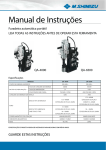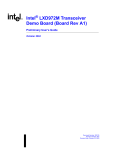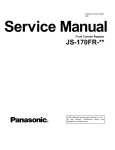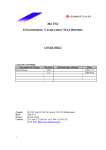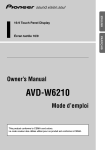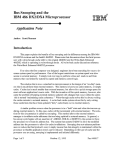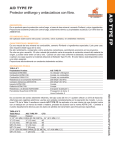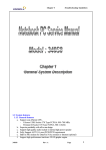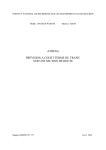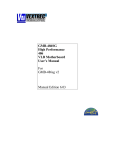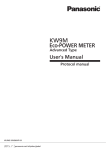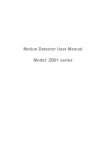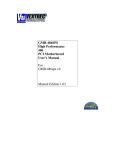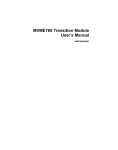Download Net486 Demonstration Board User`s Manual
Transcript
net486.book Page i Wednesday, May 26, 1999 12:24 PM Net486 Demonstration Board User’s Manual Order # 22649A net486.book Page ii Wednesday, May 26, 1999 12:24 PM Net486 Demonstration Board User’s Manual © 1999 Advanced Micro Devices, Inc. All rights reserved. The contents of this document are provided in connection with Advanced Micro Devices, Inc. (“AMD”) products. AMD makes no representations or warranties with respect to the accuracy or completeness of the contents of this publication and reserves the right to make changes to specifications and product descriptions at any time without notice. No license, whether express, implied, arising by estoppel or otherwise, to any intellectual property rights is granted by this publication. Except as set forth in AMD's Standard Terms and Conditions of Sale, AMD assumes no liability whatsoever, and disclaims any express or implied warranty, relating to its products including, but not limited to, the implied warranty of merchantability, fitness for a particular purpose, or infringement of any intellectual property right. AMD's products are not designed, intended, authorized or warranted for use as components in systems intended for surgical implant into the body, or in other applications intended to support or sustain life, or in any other application in which the failure of AMD's product could create a situation where personal injury, death, or severe property or environmental damage may occur. AMD reserves the right to discontinue or make changes to its products at any time without notice. NO SUPPORT OBLIGATION: AMD is not obligated to furnish, support, or make any further information, software, technical information, know-how, or show-how available to you. AMD, the AMD logo, and combinations thereof, E86, NetPHY, and PCnet are trademarks of, Am486 and PAL are registered trademarks of, and FusionE86 is a service mark of Advanced Micro Devices, Inc. Vantis is a trademark of Vantis Corporation. Windows and Windows NT are registered trademarks of Microsoft Corporation. Product names used in this publication are for identification purposes only and may be trademarks of their respective companies. net486.book Page iii Wednesday, May 26, 1999 12:24 PM IF YOU HAVE QUESTIONS, WE’RE HERE TO HELP YOU. The AMD customer service network includes U.S. offices, international offices, and a customer training center. Expert technical assistance is available from the AMD worldwide staff of field application engineers and factory support staff to answer E86™ family hardware and software development questions. Frequently accessed numbers are listed below. Additional contact information is listed on the back of this manual. AMD’s WWW site lists the latest phone numbers. Technical Support Answers to technical questions are available online, through e-mail, and by telephone. Go to AMD’s home page at www.amd.com and follow the Service link for the latest AMD technical support phone numbers, software, and Frequently Asked Questions. For technical support questions on all E86 products, send e-mail to [email protected] (in the US and Canada) or [email protected] (in Europe and the UK). You can also call the AMD Corporate Applications Hotline at: (800) 222-9323 44-(0) 1276-803-299 Toll-free for U.S. and Canada U.K. and Europe hotline WWW Support For specific information on E86 products, access the AMD home page at www.amd.com and follow the Embedded Processors link. These pages provide information on upcoming product releases, overviews of existing products, information on product support and tools, and a list of technical documentation. Support tools include online benchmarking tools and CodeKit software—source code example applications. Many of the technical documents are available online in PDF form. Questions, requests, and input concerning AMD’s WWW pages can be sent via e-mail to [email protected]. Documentation and Literature Support Data books, user’s manuals, data sheets, application notes, and product CDs are free with a simple phone call. Internationally, contact your local AMD sales office for product literature. To order literature, call: (800) 222-9323 (512) 602-5651 (512) 602-7639 Toll-free for U.S. and Canada Direct dial worldwide Fax Third-Party Support AMD’s FusionE86SM program partners provide an array of products designed to meet critical time-to-market needs. Products and solutions available include emulators, hardware and software debuggers, board-level products, and software development tools, among others. The WWW site and the E86™ Family Products Development Tools CD, order #21058, describe these solutions. In addition, mature development tools and applications for the x86 platform are widely available in the general marketplace. net486.book Page iv Wednesday, May 26, 1999 12:24 PM net486.book Page v Wednesday, May 26, 1999 12:24 PM Contents About the Demonstration Board Demonstration Board Features ............................................................................ xi Am486® Microprocessor................................................................................ xi Core Logic Chipset ......................................................................................... xi DRAM Main Memory.................................................................................... xii Boot and EIP Flash Memory.......................................................................... xii PC and DOS Compatibility............................................................................ xii PC Peripheral Support................................................................................... xiii Two Ethernet Controllers .............................................................................. xiii Industry-Standard Expansion ........................................................................ xiv Form Factor and Power Supply..................................................................... xiv BIOS and Software ....................................................................................... xiv Demonstration Board Documentation.................................................................xv About This Manual .........................................................................................xv Suggested Reference Material....................................................................... xvi Documentation Conventions........................................................................ xvii Net486 Demonstration Board User’s Manual v net486.book Page vi Wednesday, May 26, 1999 12:24 PM Chapter 1 Quick Start Setting Up the Board ......................................................................................... 1-2 Installation Requirements.............................................................................. 1-3 Board Installation .......................................................................................... 1-4 Starting from Flash Memory ............................................................................. 1-6 Starting from Floppy Disk ................................................................................. 1-7 Starting from an IDE Hard Disk........................................................................ 1-8 Installation Troubleshooting .............................................................................. 1-9 Chapter 2 Board Functional Description Feature and Layout Diagrams............................................................................ 2-2 Jumper Functions............................................................................................... 2-6 Board Restrictions ............................................................................................. 2-6 Board Features ................................................................................................... 2-7 Am486® Microprocessor (O15) ................................................................... 2-7 Core Logic Chipset (K15, M5, D12)........................................................... 2-10 Onboard Ethernet Controllers (I19 and G15).............................................. 2-12 Expansion Bus (G10 and P10) .................................................................... 2-13 DRAM Main Memory (F6)......................................................................... 2-14 Boot Flash Memory (M2)............................................................................ 2-15 EIP Flash Memory (K10) ............................................................................ 2-16 Super I/O (I5) .............................................................................................. 2-19 IDE Hard Disk (L1)..................................................................................... 2-22 Keyboard (A10)........................................................................................... 2-22 Power Supply (A2)...................................................................................... 2-23 Reset Switch (O20) ..................................................................................... 2-23 vi Net486 Demonstration Board User’s Manual net486.book Page vii Wednesday, May 26, 1999 12:24 PM Appendix A Default Settings Default Settings ................................................................................................ A-1 Appendix B Bill of Materials Bill of Materials.................................................................................................B-1 Index Index ........................................................................................................... Index-1 Net486 Demonstration Board User’s Manual vii net486.book Page viii Wednesday, May 26, 1999 2:26 PM List of Figures Figure 0-1. Board Overview.................................................................................................... x Figure 2-1. Board Overview (Same as Figure 0-1) .............................................................. 2-3 Figure 2-2. Board Block Diagram ........................................................................................ 2-4 Figure 2-3. Board Layout ..................................................................................................... 2-5 Figure 2-4. Am486® Microprocessor Block Diagram......................................................... 2-9 Figure 2-5. Typical Memory Map With EIP Flash Memory.............................................. 2-18 Figure 2-6. Serial Port Connector Pins............................................................................... 2-20 Figure 2-7. Parallel Port Socket.......................................................................................... 2-21 List of Tables Table 0-1. Notational Conventions ................................................................................ xvii Table 1-1. Installation Troubleshooting ............................................................................. 1-9 Table 2-1. Board Jumper Summary .................................................................................. 2-6 Table 2-2. PCI Configuration Addressing ....................................................................... 2-10 Table 2-3. Serial Port Pin/Signal Table ............................................................................ 2-20 Table 2-4. Parallel Port Pin/Signal Table.......................................................................... 2-21 Table 2-5. Switch Summary.............................................................................................. 2-23 Table A-1. Default Jumper Settings.................................................................................... A-1 viii Net486 Demonstration Board User’s Manual net486.book Page ix Wednesday, May 26, 1999 12:24 PM About the Demonstration Board Congratulations on your decision to design with the Am486® microprocessor. The Net486 demonstration board provides a single-board demonstration of an embedded Am486 microprocessor-based communication controller with two onboard 10- or 100-Mbit/s Ethernet controllers and a PC/104-Plus expansion bus. The Net486 demonstration board includes 8.5 Mbytes of Flash memory, a PC/104Plus connector with access to both PCI and ISA buses, and standard PC peripherals. In addition, the platform’s compact, targeted design makes it suitable for demonstrating customer designs in a sales environment. Refer to the Am486 microprocessor documentation (listed on page xvi) for detailed information on the Am486 microprocessor. Figure 0-1 on page x provides an overview of the Net486 demonstration board’s features. Net486 Demonstration Board User’s Manual ix net486.book Page x Wednesday, May 26, 1999 12:24 PM DRAM One 72-pin SIMM Socket Supports 32 Mbytes of EDO or FPM DRAM 32 Mbytes of 60-ns DRAM Installed Am486® Microprocessor EIP Flash Memory Addressed as fourth DRAM bank 8-Mbyte Flash Memory Fast Read Access CPU Bus PCnet™-Fast+ Ethernet Controller ALi M1489 Memory, and DRAM Controller (Northbridge Chip) PCI Bus Am79C972 Device Included (Am79C973 Device Supported) 10/100Base-T Port (RJ-45) Three Connection Status LEDs PCnet™-Home Ethernet Controller IDE Interface Am79C978 Device 10Base-T Port (RJ-45) HomePNA Port (RJ-11) Three Connection Status LEDs 2-mm-Pitch Ribbon Connector Supports up to Two Devices Connector Status LED ALi M1487 ISA Bridge (Southbridge Chip) PCI Bus Arbiter Reset Switch PC/104 Plus Expansion Compact Stacked Interface PCI and ISA Buses ISA Bus ALi M5113A Super I/O IrDA Module 2 Serial Interfaces (one DB-9, one 10-pin header) 1 Parallel Port Floppy Disk Interface Boot FlashSocket 32-pin PLCC Package Up to 512K x8 Supported BIOS Included Figure 0-1. Board Overview x Net486 Demonstration Board User’s Manual M5042 Keyboard Controller AT Keyboard Controller net486.book Page xi Wednesday, May 26, 1999 12:24 PM Demonstration Board Features This section describes the following features of the Net486 demonstration board: • • • • • • • • • • “Am486® Microprocessor” on page xi “Core Logic Chipset” on page xi “DRAM Main Memory” on page xii “Boot and EIP Flash Memory” on page xii “PC and DOS Compatibility” on page xii “PC Peripheral Support” on page xiii “Two Ethernet Controllers” on page xiii “Industry-Standard Expansion” on page xiv “Form Factor and Power Supply” on page xiv “BIOS and Software” on page xiv Am486® Microprocessor • 133 MHz AMD Am486DX5 microprocessor is included. • Factory option to use 100 MHz Am486DX4 microprocessor. • 208-pin low-cost SQFP package with internal heat spreader. Core Logic Chipset • Acer Labs FINALi 486 PCI chipset – M1489 Northbridge cache, memory, and PCI controller – M1487 Southbridge ISA bus controller – M5042 mouse/keyboard controller Net486 Demonstration Board User’s Manual xi net486.book Page xii Wednesday, May 26, 1999 12:24 PM DRAM Main Memory • Supports one bank of 32- or 36-bit-wide, 16-Mbit technology DRAM using an industry-standard 5-V 72-pin SIMM. DRAM can be fast page mode (FPM) or extended data out (EDO). • 32 Mbyte of 60-ns EDO DRAM SIMM installed in the provided slot. • DRAM is accessible by CPU and PCI bus masters. • L1 cache snoop cycles are generated for PCI master memory accesses. Boot and EIP Flash Memory • 32-pin PLCC boot Flash memory socket addressed at the reset vector. 512-Kbyte x8 boot Flash BIOS is included. • 8-Mbyte Flash memory for execute-in-place (EIP) applications, located on the memory bus in place of one DRAM bank. EIP Flash is implemented using an AMD 22V10 PAL® device for glue logic. PC and DOS Compatibility • Off-the-shelf PC chipset provides common I/O functions found in a PC: - Two 82C59-compatible interrupt controllers - One 82C54-compatible programmable interval timer - Two 82C37-compatible DMA controllers (seven channels) - DS1287-compatible real-time clock (RTC) xii Net486 Demonstration Board User’s Manual net486.book Page xiii Wednesday, May 26, 1999 12:24 PM PC Peripheral Support • One IDE connector with LED (interface provided by chipset’s M1489 device). • M5113A super I/O device functions: – Two 16550-compatible serial ports. – One parallel port with Error and Ready status LEDs. Supports Centronics, bidirectional, enhanced parallel port (EPP), and extended capabilities port (ECP) interfaces. – IrDA port (115 Kbyte/s). – Floppy disk interface. • PC/AT keyboard connector (interface provided by M5042 device). Two Ethernet Controllers • AMD PCnet™-Fast+ Ethernet controller chip, Am79C972. – External PHY transceiver supports full duplex – Design supports alternative Am79C973 controller with internal transceiver. – RJ-45 connector for operation at 10 or 100 Mbit/s. • AMD PCnet™-Home Ethernet controller chip, Am79C978. – Internal PHY transceiver supports full duplex. – RJ-45 connector for 10 Mbit/s operation. – Two RJ-11 connectors for 1 Mbit/s Home Phoneline Networking Alliance (HomePNA) operation. • Features supported by both onboard Ethernet controllers: – 32-bit PCI bus interface with bus mastering capability. – Integrated 12-Kbyte buffer. – Preprogrammed 1-Kbyte serial EEPROM included for Ethernet configuration. – IEEE802.3 and NetPC compliance. – LED indicators for transmit activity, receive activity, and link speed. Net486 Demonstration Board User’s Manual xiii net486.book Page xiv Wednesday, May 26, 1999 12:24 PM Industry-Standard Expansion • PC/104-Plus connector. Form Factor and Power Supply • Compact 5 x 7” form factor with connectors and LEDs placed for convenient demonstration. • Power provided by a single, 12-V power supply. BIOS and Software The included diskette or CD-ROM contains information about the included BIOS and any additional utility and demonstration software for the Net486 demonstration board. xiv Net486 Demonstration Board User’s Manual net486.book Page xv Wednesday, May 26, 1999 12:24 PM Demonstration Board Documentation The Net486 Demonstration Board User’s Manual provides information on the design and function of the development platform. The software shipped with the board is described in the README files and online BIOS manual included with your kit. The included online documentation is in either text or Adobe Acrobat (PDF) format. The latest Acrobat Reader is available from Adobe’s site on the World Wide Web (currently at www.adobe.com). About This Manual Chapter 1, “Quick Start” helps you quickly set up and start using the demonstration board. Chapter 2, “Board Functional Description” contains descriptions of the basic sections of the board: layout, microprocessor, core logic chipset, Ethernet controller, DRAM, boot and Flash memory, PC/104-Plus bus interface, super I/O, hard disk, keyboard, IDE interface, power, and switches. Appendix A, “Default Settings” summarizes the jumper positions on the board when it is shipped. Appendix B, “Bill of Materials” shows the bill of materials for the board, and the actual CAD schematics used to build the board. An index is also included. Net486 Demonstration Board User’s Manual xv net486.book Page xvi Wednesday, May 26, 1999 12:24 PM Suggested Reference Material The following AMD documentation may be of interest to the Net486 demonstration board user. For information on ordering literature, see page iii. • Enhanced Am486®DX Microprocessor Family Data Sheet, order #20736 • Am486®DX/DX2 Microprocessor Hardware Reference Manual, order #17965 • Am486® Microprocessor Software User’s Manual, order #18497 • Am79C972 PCnet™-FAST+ Enhanced 10/100 Mbps PCI Ethernet Controller with OnNow Support Data Sheet, order #21485 • Am79C972 PCnet™-Home Single-Chip 1/10 Mbps PCI Home Networking Controller Data Sheet, order #22206 • E86 Family Products Development Tools CD, order #21058 • Flash Memory Products Data Book, order #11796 For current application notes and technical bulletins, see our World Wide Web page at www.amd.com. The following non-AMD documents are also recommended: • FINALi 486 M1489/1487 PCI Chip Set Preliminary Data Sheet Acer Laboratories Inc. See www.acerlabs.com for contact information. Related BIOS guidelines, errata, and application documents are also available. • M5113: Enhanced Super I/O Controller Data Sheet Acer Laboratories Inc. See www.acerlabs.com for contact information. xvi Net486 Demonstration Board User’s Manual net486.book Page xvii Wednesday, May 26, 1999 12:24 PM Documentation Conventions The Advanced Micro Devices Net486 Demonstration Board User’s Manual uses the conventions shown in Table 0-1 (unless otherwise noted). These same conventions are used in all the E86™ family support product manuals. Table 0-1. Notational Conventions Symbol Usage Boldface Indicates that characters must be entered exactly as shown, except that the alphabetic case is only significant when indicated. Italic Indicates a descriptive term to be replaced with a user-specified term. Typewriter face Indicates computer text input or output in an example or listing. Net486 Demonstration Board User’s Manual xvii net486.book Page xviii Wednesday, May 26, 1999 12:24 PM xviii Net486 Demonstration Board User’s Manual net486.book Page 1 Wednesday, May 26, 1999 12:24 PM Chapter 1 Quick Start This chapter provides information that helps you quickly set up and start using the Net486 demonstration board (Net486 demonstration board). The Net486 demonstration board is shipped with a BIOS that has been configured specifically for the chipset used on this platform. The BIOS contains the code that enables the Net486 demonstration board to function as a standard AT-compatible PC, using an AT-compatible keyboard and display and a PC/104-Plus-compatible VGA display adapter. The included BIOS software also supports redirection of the command-line console to the serial port and configuration of onboard Flash memory as a resident flash disk (RFD) that can also be set up as a boot device. See the online BIOS manual included with your kit for information about booting from an RFD. Details on the included BIOS can be found in the online BIOS documentation shipped with your kit. The Net486 demonstration board can run AT-compatible operating system software. You can start the system from Flash memory (if so configured), from a bootable floppy disk, or from an attached IDE hard disk drive that already has the operating system installed. For information on how to: • Set up the Net486 demonstration board, see page 1-2. • Boot the Net486 demonstration board from Flash memory, see page 1-6. • Boot the Net486 demonstration board from a floppy disk, see page 1-7. • Boot the Net486 demonstration board from a hard disk, see page 1-8. • Troubleshoot installation problems, see page 1-9. Net486 Demonstration Board User’s Manual 1-1 net486.book Page 2 Wednesday, May 26, 1999 12:24 PM Setting Up the Board ! CAUTION: As with all computer equipment, the Net486 demonstration board may be damaged by electrostatic discharge (ESD). Please take proper ESD precautions when handling any board. Warning: Read before using this board Before applying power, the following precautions should be taken to avoid damage or misuse of the board: • Make sure the provided power supply is plugged into the board’s power connector correctly. See “Power Supply (A2)” on page 2-23 for details. • See Figure 2-3 on page 2-5 for connector positions. • Check the floppy disk or CD-ROM that was shipped with your kit for README or errata documentation. Read all the information carefully before continuing. For current application notes and technical bulletins, see the AMD World Wide Web page at www.amd.com and follow the link to Embedded Systems. 1-2 Net486 Demonstration Board User’s Manual net486.book Page 3 Wednesday, May 26, 1999 12:24 PM Installation Requirements You need to provide the following items (in addition to the board from the kit). Required for redirected-console operation: • An ANSI terminal or a PC running ANSI terminal emulation software • A null-modem cable Required for stand-alone operation: • A VGA-compatible monitor • A PC/104-Plus video card that supports VGA • A cable to connect the monitor to the video card • An AT-compatible keyboard To boot from a floppy disk: • An AT-compatible floppy disk drive • A bootable DOS floppy disk • A compact (notebook-style) floppy disk ribbon cable. You also need a ribbon cable adapter if the floppy disk drive requires a 0.1-inch-pitch connector. To boot from a hard disk: • An IDE-compatible hard disk drive • AT-compatible operating system (preinstalled on the hard disk drive) • A compact (notebook-style) 44-pin 2-mm-pitch hard-disk-drive cable. You also need a cable adapter if your hard disk drive requires a 0.1-inch-pitch connector. Only one boot disk image (Flash memory, floppy disk, or hard disk) is required. For example, you can boot from a floppy disk to configure a resident flash disk and install the operating system, and then start from Flash memory from then on. ! CAUTION: Use the configuration described here when you first start the Net486 demonstration board. Before using other features, read the appropriate sections in Chapter 2, “Board Functional Description.” The combined +5 V current requirement for disk drives and expansion devices must not exceed 1.1 A. See “Power Budget” on page 2-13. Net486 Demonstration Board User’s Manual 1-3 net486.book Page 4 Wednesday, May 26, 1999 12:24 PM Board Installation NOTE: See Figure 2-2 on page 2-4 for a block diagram of the board. See Figure 2-3 on page 2-5 for a layout diagram of the board, including connector locations referenced in this section. ! DANGER: Make sure the power supply and the VGA monitor are not plugged into an electrical outlet during the following steps. 1. Remove the board from the shipping carton. Visually inspect the board to verify that it was not damaged during shipment. The following steps assume the board’s jumpers are in the factory default configuration (settings are listed in Appendix A, “Default Settings”). 2. If you are installing a floppy disk drive, perform the following steps: a. Inspect the 34-lead, floppy-disk-drive ribbon cable that you are providing. Note the contacts (metallic pads) of the cable end. b. Connect one end of the ribbon cable to the ribbon connector (connector J12 at location H1) on the Net486 demonstration board. Orient the ribbon so its contacts are facing the edge of the board. Lift the clamping bar on the board connector; slide in the ribbon; then press the clamping bar down again to secure the ribbon. c. Connect the other end of the ribbon cable to the floppy disk drive. The connector’s orientation should be indicated in the drive documentation, or marked near the connector on the drive. 3. If you are installing a hard disk drive, perform the following steps: a. Inspect the 44-wire IDE ribbon cable that you are providing. Note the red wire or any other marking that indicates wire 1 on the cable. b. Connect one end of the 44-wire IDE cable to the hard disk drive. The connector’s orientation should be indicated in the drive documentation, or marked near the connector on the drive. Usually wire 1 is oriented towards the drive’s power cable connector. c. Connect the other end of the 44-wire IDE cable to the 44-pin connector (connector J14 at location M1) on the Net486 demonstration board (with wire 1 oriented towards the floppy disk drive connector). 1-4 Net486 Demonstration Board User’s Manual net486.book Page 5 Wednesday, May 26, 1999 12:24 PM 4. If you are setting up for redirected-console operation, connect the null-modem cable that you provided between the COM1 connector on the Net486 demonstration board (connector J6 at location A7) and the appropriate serial port of your terminal or PC. 5. If you are setting up for stand-alone operation, perform the following steps: a. Insert a PC/104-Plus VGA-compatible video card into the PC/104-Plus headers (parts J11, J15 and J16 at locations G10 and P10) b. Connect the monitor cable from the monitor to the D-connector on the video card just as you would for a standard PC. c. Connect the AT keyboard to the keyboard connector (connector J5 at location A10). 6. Connect the +12 V DC output cable from the provided AC adapter to the +12-V power connector on the Net486 demonstration board (part J8 at location A2). ! CAUTION: Failure to use the correct AC adapter can damage the Net486 demonstration board. The combined +5 V current requirement for disk drives and expansion devices must not exceed 1.1 A. See “Power Budget” on page 2-13. Net486 Demonstration Board User’s Manual 1-5 net486.book Page 6 Wednesday, May 26, 1999 12:24 PM Starting from Flash Memory NOTE: See the online documentation for the included BIOS if your Net486 demonstration board does not already have a resident flash disk (RFD) configured and an operating system installed. The operating system used must be able to operate entirely within a command-line console environment. Use the following steps to start the Net486 demonstration board from a resident flash disk using console redirection: 1. Make sure you have installed the Net486 demonstration board correctly as described in “Setting Up the Board” on page 1-2. 2. Configure your ANSI terminal or terminal emulation software with the following settings: – – – – 9600 bits/s 8 data bits No parity 1 stop bit 3. Plug in the AC adapter. 4. Turn on the power switch (part S1 at location A4). The power LED should light. The speaker should beep and the terminal should start displaying startup information. 5. The first time you start the system, the BIOS might display a message reporting a CMOS error or some other BIOS configuration problem. Follow the instructions shown on the screen to enter the Setup utility. Once you are in the Setup utility, you can set the system’s date, time, startup drive, and other options. The BIOS setup utility is also used to configure and format the RFD before installing an operating system in Flash memory. For more information on the included BIOS, see the online BIOS manual included with your kit. 6. The system should now boot from the DOS RFD just like a standard PC. If you encounter any problems, see “Installation Troubleshooting” on page 1-9. 1-6 Net486 Demonstration Board User’s Manual net486.book Page 7 Wednesday, May 26, 1999 12:24 PM Starting from Floppy Disk Use the following steps to start the Net486 demonstration board from a bootable floppy disk: 1. Make sure you have installed the Net486 demonstration board correctly as described in “Setting Up the Board” on page 1-2. 2. Plug the VGA monitor into an electrical outlet and turn it on. 3. Plug in the AC adapter. 4. Insert a bootable DOS floppy disk (not included) in the disk drive. 5. Turn on the power switch (part S1 at location A4). The power LED should light. The speaker should beep and the monitor should start displaying startup information. 6. The first time you start the system, the BIOS might display a message reporting a CMOS error or some other BIOS configuration problem. Follow the instructions shown on the screen to enter the Setup utility. Once you are in the Setup utility, you can set the system’s date, time, startup drive, and other options. The BIOS setup utility is also used to configure and format a resident flash disk (RFD) before installing an operating system in Flash memory. For more information on the included BIOS, see the online BIOS manual included with your kit. 7. Save and exit the setup utility. 8. The system should now boot from the DOS floppy disk just like a standard PC. If you encounter any problems, see “Installation Troubleshooting” on page 1-9. Net486 Demonstration Board User’s Manual 1-7 net486.book Page 8 Wednesday, May 26, 1999 12:24 PM Starting from an IDE Hard Disk Use the following steps to start up the Net486 demonstration board from an IDE hard disk on which you have preinstalled an operating system (while it was connected to another PC): 1. Make sure you have installed the Net486 demonstration board correctly as described in “Setting Up the Board” on page 1-2. 2. Plug the VGA monitor into an electrical outlet and turn it on. 3. Plug in the AC adapter. 4. If a floppy disk drive is installed, make sure it is empty. 5. Turn on the power switch (part S1 at location A4). The power LED should light. The speaker should beep and the monitor should start displaying startup information. 6. The first time you start the system, the BIOS might display a message reporting a CMOS error or some other BIOS configuration problem. Follow the instructions shown on the screen to enter the Setup utility. Once you are in the Setup utility, you can set the system’s date, time, startup drive, and other options. 7. In the BIOS setup utility, use the automatic configuration option to set up Drive C. Select either physical addressing or logical block addressing (LBA) as appropriate for your hard disk drive. The BIOS setup utility is also used to configure and format a resident flash disk (RFD) before installing an operating system in Flash memory. For more information on the included BIOS, see the online BIOS manual included with your kit. 8. Save and exit the setup utility. 9. The system should now boot using the operating system on the hard disk. If you encounter any problems, see “Installation Troubleshooting” on page 1-9. 1-8 Net486 Demonstration Board User’s Manual net486.book Page 9 Wednesday, May 26, 1999 12:24 PM Installation Troubleshooting Table 1-1. Installation Troubleshooting Problem Solution The power LED does not light after I turn on the power switch. Make sure the correct AC power adapter is plugged in and correctly attached to the board. I see nothing on the display and do not hear any beeps from the speaker. I do not hear the head synchronization on the floppy disk drive (if attached). Ensure processor reset by pressing the Reset button (part S2 at location P20). Check that the BIOS Flash memory is correctly installed in its socket (part U27 at location M2). Make sure all cables are connected properly, all adapters are seated firmly in their slots, and the CMOS battery is correctly installed. If the problem persists, invalidate the CMOS RAM by temporarily moving jumper W1 from pins 1–2 to connect pins 2–3; wait a few seconds, then move the jumper back to pins 1–2. This makes it necessary to run the Setup utility and restore startup settings, but it also clears any corrupted settings that might be present. I am using a redirected console. I hear a beep on the speaker but see nothing on my terminal screen. Make sure your terminal or terminal emulator supports ANSI and is configured correctly (8, N, 1, 9600 baud). Make sure you are using a null-modem cable and that the cable is connected to the correct port on your terminal and to the Net486 demonstration board’s COM1 port (part J6 at location A0). I am using a stand-alone installation. I hear a beep on the speaker but see nothing on the VGA monitor. Check that the monitor is plugged in and turned on, that it is correctly connected to the video card, and that the video card is correctly seated in the connectors. Check that the video card supports VGA. Net486 Demonstration Board User’s Manual 1-9 net486.book Page 10 Wednesday, May 26, 1999 12:24 PM Table 1-1. Installation Troubleshooting (Continued) Problem Solution I see the startup information on the monitor but the memory test stops at an incorrect memory size (1 Mbyte equals 1024 Kbyte). Make sure the SIMM that came with the kit is securely installed in the SIMM socket. I see the startup information on the monitor but it says there’s a battery problem or CMOS checksum error and the system doesn’t finish booting. Follow the BIOS instructions to run the Setup utility to configure the CMOS RAM and save settings. I configured the CMOS RAM and saved my settings, but settings are lost the next time I turn on the Net486 demonstration board. Make sure a fresh 3.0-V 20-mm coin cell is installed correctly (“+” side facing up) in the BT1 battery holder at location L19. I don’t hear any sound from the floppy disk drive and the system does not boot from a floppy disk. Check that the ribbon cable to the floppy disk drive is properly connected at both the drive end and the board end (board connector J12 at location H1). Check the drive documentation to verify which side of the ribbon is lead 1, and orient that lead towards the front of the board. Check that the CMOS setup indicates that drive A is the correct size and capacity for your floppy disk drive. I hear the floppy disk being accessed but get an error message “Non System disk” or “Drive A not found.” Check that the floppy disk in the drive is bootable, just as you would on a standard PC. Make sure the floppy disk drive is connected properly. In the BIOS setup utility, make sure the BIOS is configured to boot from floppy disk, and that the floppy disk size and density is configured properly. I get a “Missing Keyboard” error message on the monitor during boot-up. Check that an AT-style keyboard is properly connected. The BIOS debugging monitor prompt is displayed. Check that the DRAM and any PC/104-Plus devices are installed correctly and known to be functional. 1-10 Net486 Demonstration Board User’s Manual net486.book Page 11 Wednesday, May 26, 1999 12:24 PM Table 1-1. Installation Troubleshooting (Continued) Problem Solution I have installed a hard disk with a preinstalled operating system, but the Net486 demonstration board won’t access the hard disk. Check that the 44-wire IDE cable is properly connected at both the drive end and the board end (board connector J14 at location M1). Check that the CMOS setup is configured correctly for your drive. Make sure the board will start from a bootable floppy disk in drive A. Then try to do a directory listing of drive C. If the directory listing of C works, the drive is functioning and there is a problem with the drive’s boot block or system image. (Note that some operating systems will display an error if you list an empty directory. If this happens, try copying a file to the drive; then do a directory listing again. If this fails, check the drive for boot block viruses.) Make sure the drive functions properly on a different system. There is a problem you cannot resolve. Check that the board is set to its default settings (see Appendix A, “Default Settings”). Contact the AMD Technical Support Hotline (see page iii). Net486 Demonstration Board User’s Manual 1-11 net486.book Page 12 Wednesday, May 26, 1999 12:24 PM 1-12 Net486 Demonstration Board User’s Manual net486.book Page 1 Wednesday, May 26, 1999 12:24 PM Chapter 2 Board Functional Description The Net486 demonstration board provides a compact demonstration system for Am486 microprocessor-based designs. Read the following sections to learn more about the board: • • • • “Feature and Layout Diagrams” on page 2-2 “Jumper Functions” on page 2-6 “Board Restrictions” on page 2-6 “Board Features” on page 2-7 – – – – – – – – – – – – “Am486® Microprocessor (O15)” on page 2-7 “Core Logic Chipset (K15, M5, D12)” on page 2-10 “Onboard Ethernet Controllers (I19 and G15)” on page 2-12 “Expansion Bus (G10 and P10)” on page 2-13 “DRAM Main Memory (F6)” on page 2-14 “Boot Flash Memory (M2)” on page 2-15 “EIP Flash Memory (K10)” on page 2-16 “Super I/O (I5)” on page 2-19 - “IrDA Interface (Q19)” on page 2-19 - “Floppy Disk Drive (E20)” on page 2-19 - “Serial Ports (A7 and K2)” on page 2-20 - “Parallel Port (H2)” on page 2-21 “IDE Hard Disk (L1)” on page 2-22 “Keyboard (A10)” on page 2-22 “Power Supply (A2)” on page 2-23 “Reset Switch (O20)” on page 2-23 See the appendices for information about default board settings and bill of materials. Schematics for the Net486 demonstration board are provided in a separate document. Net486 Demonstration Board User’s Manual 2-1 net486.book Page 2 Wednesday, May 26, 1999 12:24 PM Feature and Layout Diagrams The following figures summarize the features and layout of the Net486 demonstration board. • Figure 2-1 on page 2-3 provides an overview of the board’s features. • Figure 2-2 on page 2-4 is the block diagram for the board. • Figure 2-3 on page 2-5 shows the board layout and component locations. 2-2 Net486 Demonstration Board User’s Manual net486.book Page 3 Wednesday, May 26, 1999 12:24 PM DRAM One 72-pin SIMM Socket Supports 32 Mbytes of EDO or FPM DRAM 32 Mbytes of 60-ns DRAM Installed Am486® Microprocessor EIP Flash Memory Addressed as fourth DRAM bank 8-Mbyte Flash Memory Fast Read Access CPU Bus PCnet™-Fast+ Ethernet Controller ALi M1489 Memory, and DRAM Controller (Northbridge Chip) PCI Bus Am79C972 Device Included (Am79C973 Device Supported) 10/100Base-T Port (RJ-45) Three Connection Status LEDs PCnet™-Home Ethernet Controller IDE Interface Am79C978 Device 10Base-T Port (RJ-45) HomePNA Port (RJ-11) Three Connection Status LEDs 2-mm-Pitch Ribbon Connector Supports up to Two Devices Connector Status LED ALi M1487 ISA Bridge (Southbridge Chip) PCI Bus Arbiter Reset Switch PC/104 Plus Expansion Compact Stacked Interface PCI and ISA Buses ISA Bus ALi M5113A Super I/O Boot FlashSocket IrDA Module 2 Serial Interfaces (one DB-9, one 10-pin header) 1 Parallel Port Floppy Disk Interface 32-pin PLCC Package Up to 512K x8 Supported BIOS Included M5042 Keyboard Controller AT Keyboard Controller Figure 2-1. Board Overview (Same as Figure 0-1) Net486 Demonstration Board User’s Manual 2-3 net486.book Page 4 Wednesday, May 26, 1999 12:24 PM CPU Bus Am486® CPU Buffer ALi M1489 Northbridge CPU Clock 5V Regulator IDE Conn. 32 Mbyte DRAM PCI Bus PCnet™-FAST+ Ethernet NetPHY™ Device RJ-45 Conn. RJ-45 Conn. 3.3 V Regulator PCnet™-Home Ethernet RJ-11 Conn. PC/104-Plus Connector +12 V Power Conn. ALi M1487 Southbridge ISA Bus ALi M5113 Super I/O Speaker Boot Flash Memory COM1 Conn. Serial Translator IrDA LEDs COM2 Header Serial Translator Parallel Header Figure 2-2. Board Block Diagram 2-4 8 Mbyte Flash Memory PAL® Device Net486 Demonstration Board User’s Manual ALi M5042 Keyboard Controller Keyboard Conn. net486.book Page 5 Wednesday, May 26, 1999 12:24 PM A B C D E F G H I J K L M N O P Q Pin 1 1 2 +12 V Conn. Parallel Port Pin 1 Pin 1 1 IDE Hard Disk Conn. Pin 1 Floppy Disk Conn. COM2 Power/ Status LEDs BIOS 3 On/ Off 4 3 4 M5113 Super I/O 5 5 M1487 DRAM SIMM 6 7 2 6 Southbridge 7 PAL® Logic COM1 8 8 9 9 10 PC/104 Plus PCI KBD PC/104 Plus ISA EIP Flash Memory 11 10 11 M5042 KBD 12 12 1 Mbit/s HomePNA Conn. 13 14 13 14 1 Mbit/s HomePNA Conn. 15 Am79C978 PCnet™-Home Controller Boot 16 10 Mbit/s ROM Ethernet Conn. 15 Am486® Microprocessor M1489 Northbridge 16 17 17 18 10/100 Mbit/s Ethernet Conn. 19 Am79C972 or Am79C973 PCnet™-Fast Controller Am79C873 NetPHY™ 18 IrDA Speaker Battery 20 19 20 Reset A B C D E F G H I J K L M N O P Q Figure 2-3. Board Layout Net486 Demonstration Board User’s Manual 2-5 net486.book Page 6 Wednesday, May 26, 1999 12:24 PM Jumper Functions Table 2-1 describes the configuration jumpers on the Net486 demonstration board. Table 2-1. Board Jumper Summary Part Signal Description Location in See Figure 2-3 Schematics* on Page 2-5 on W1 VBAT Used to invalidate the CMOS RAM for test purposes. K20 Sheet 7 W2 PPE Used to assert the parallel port’s PPE signal. This jumper is ignored by the included BIOS, but custom initialization software can interpret this signal as a user startup option. K3 Sheet 14 *Schematics are provided in a separate document in your kit. Board Restrictions • Using a PCI chipset with the Am486 microprocessor is a fast and effective way to design a working system, but the system’s features can be limited by the chipset’s capabilities. • The chipset does not directly support ROM or Flash memory devices except for the boot memory. It is possible to implement Flash memory on the DRAM bus (as in this design’s EIP Flash memory), or on the PCI or ISA bus, but the chipset only allows booting from the boot memory. • The Net486 demonstration board implements two banks of execute-in-place (EIP) Flash memory in place of one DRAM bank. Flash memory timing requirements limit the chipset’s DRAM interface to its Fast (not Fastest) speed when the Flash memory is used. This is equivalent to using 70-ns fast-pagemode (FPM) DRAM. 2-6 Net486 Demonstration Board User’s Manual net486.book Page 7 Wednesday, May 26, 1999 12:24 PM • The ISA peripherals provided by the M1487 chip are configured for standard PC-AT compatibility, so there is not much flexibility in assigning interrupts and DMA channels. • The Net486 demonstration board does not implement OnNow or Advanced Configuration and Power Interface (ACPI) power management. Board Features The remainder of this chapter describes the features of the Net486 demonstration board. The number in parentheses following each heading indicates the part’s location in Figure 2-3 on page 2-5. In addition, other locations mentioned can be found in the figure. Part numbers mentioned refer to the part reference numbers in the bill of materials and schematics. See Appendix B, “Bill of Materials”. Am486® Microprocessor (O15) The Net486 demonstration board includes an Am486 microprocessor in a 168-pin, pin-grid-array package (part U31). A CPU heat sink is provided for cooling. The Enhanced Am486DX Microprocessor Family boosts system performance by incorporating a 16-Kbyte cache to the existing flexible clock control and enhanced System Management mode (SMM) features of a 486 CPU. The Enhanced Am486DX Microprocessor Family has the following characteristics: • Industry-standard write-back cache support • Frequent instructions execute in one clock • 105.6-million bytes/second burst bus at 33 MHz • Flexible write-through and write-back address control • Advanced 0.35-µ CMOS-process technology • 3.3-V or 3.45-V core with 5-V tolerant I/O • Dynamic data bus sizing for 8-, 16-, and 32-bit buses (the Net486 demonstration board uses a 32-bit data bus) • 32-bit address bus • 32-bit registers • Supports “soft reset” capability Net486 Demonstration Board User’s Manual 2-7 net486.book Page 8 Wednesday, May 26, 1999 12:24 PM • 16-Kbyte unified code and data cache – Four-way set-associative – Write-through or write-back policy (the board uses write-back policy by default) • Floating-point unit • Paged, virtual memory management • Stop clock control for reduced power consumption • Industry-standard two-pin System Management Interrupt (SMI) for power management independent of processor operating mode and operating system • Static design with Auto Halt power-down support • Wide range of chipsets supporting SMM available to allow product differentiation (the Net486 demonstration board uses the Acer Laboratories Inc. FINALi 486 chipset) • Support available through the AMD FusionE86SM program 2-8 Net486 Demonstration Board User’s Manual net486.book Page 9 Wednesday, May 26, 1999 12:24 PM VOLDET Power Plane 32-Bit Data Bus Clock Interface 32-Bit Data Bus Clock Generator 32-Bit Linear Address Barrel Shifter Register File Descriptor Registers 24 Physical Address ALU Limit and Attribute PLA Cache Unit 2 32 Paging Unit 24 Translation Lookaside Buffer Physical Address 16-Kbyte Cache Prefetcher 32 Micro-instruction Code Stream Floating Point Unit Floating Point Register File Central and Protection Test Unit Control ROM Instruction Decode Address Drivers Write Buffers 4x32 Writeback Buffers 4x32 32 Data Bus Transceivers 32-Byte Code Queue 2x16 Bytes 24 A31–A2 BE3–BE0 Copyback Buffers 4x32 128 Displacement Bus CLK CLKMUL STPCLK Bus Interface PCD, PWT Segmentation Unit VCC, VSS Bus Control Request Sequencer Decoded Instruction Path D31–D0 ADS, W/R, D/C, M/IO, PCD, PWT, RDY, LOCK, PLOCK, BOFF, A20M, BREQ, HOLD, HLDA, RESET, INTR, NMI, FERR, UP, IGNNE, SMI, SMIACT, SRESET Burst Bus Control BRDY, BLAST Bus Size Control BS16, BS8 Cache Control Parity Generation and Control JTAG KEN, FLUSH, AHOLD, CACHE, EADS, INV, WB/WT, HITM PCHK, DP3–DP0 TDI, TCK, TDO, TMS Figure 2-4. Am486® Microprocessor Block Diagram Net486 Demonstration Board User’s Manual 2-9 net486.book Page 10 Wednesday, May 26, 1999 12:24 PM Core Logic Chipset (K15, M5, D12) The Net486 demonstration board uses the Acer Laboratories Inc. FINALi 486 chipset. The chipset consists of two very-large-scale-integration (VLSI) devices that provide bus interface and peripheral functions used in the system, plus an M5042 keyboard controller. See “Keyboard (A10)” on page 2-22. The M1489 cache, memory, and PCI controller (often called a Northbridge chip) interfaces the Am486 microprocessor to the memory and PCI bus. The M1489 (part U26 at location K15) performs the following functions: • Controls DRAM accesses and refresh cycles. See “DRAM Main Memory (F6)” on page 2-14. • Provides a 33-MHz, PCI 2.0-compliant interface with 5-V signaling. See “Expansion Bus (G10 and P10)” on page 2-13. • Maintains level-1 and level-2 cache coherency for PCI-master-initiated memory cycles. (Level-2 cache is not implemented in this design.) • Provides an IDE controller for a hard disk drive. See “IDE Hard Disk (L1)” on page 2-22. The Net486 demonstration board routes six PCI address signals via series resistors to the IDSEL pins on the PC/104-Plus PCI connector and the onboard Ethernet controllers. The chipset asserts one of these signals to configure each device according to the device number written to the chipset’s configuration address register. Table 2-2 relates each device to its device number and signal routing. Table 2-2. PCI Configuration Addressing PCI Device Device Number Address Signal ID Select Signal See Schematics* on Am79C972 Ethernet Device 5 PAD21 IDSEL972 Sheet 12 Am79C978 Ethernet Device 6 PAD22 IDSEL978 Sheet 10 PC/104-Plus Device 7 PAD23 IDSEL0 Sheet 8 *Schematics are provided in a separate document in your kit. 2-10 Net486 Demonstration Board User’s Manual net486.book Page 11 Wednesday, May 26, 1999 12:24 PM Table 2-2. PCI Configuration Addressing (Continued) PCI Device Device Number Address Signal ID Select Signal See Schematics* on PC/104-Plus Device 8 PAD24 IDSEL1 Sheet 8 PC/104-Plus Device 9 PAD25 IDSEL2 Sheet 8 PC/104-Plus Device 10 PAD26 IDSEL3 Sheet 8 *Schematics are provided in a separate document in your kit. The M1487 ISA bridge controller (often called a Southbridge chip) interfaces the ISA bus to the PCI bus and provides standard, PC-compatible peripherals devices common to desktop computers. The M1487 (Part U25 at location M5) provides the following peripheral functions: • Two 82C59 interrupt controllers • One 82C54 programmable interval timer • Two 82C37 DMA controllers • A real-time clock (RTC) • External boot memory decoding The M1487’s integrated peripherals are configured for standard PC-AT compatibility, so there is not much flexibility in assigning interrupts and DMA channels. The M1487 also contains the PCI bus arbiter, which allows three additional masters. The Net486 demonstration board board uses two master request/grant interfaces for the two onboard Ethernet controllers. The remaining master interface is routed to the PC/104-Plus PCI connector. The M1489 and M1487 communicate with each other across their proprietary LinkBus. The LinkBus has no separate pins, but instead uses the CPU address pins A2 to A17. The LinkBus handles the RTC, keyboard controller, and boot memory transactions as well; this is why CPU address pins are routed to these devices in the schematics. The chipset asserts the Am486 microprocessor’s AHOLD input to three-state its address pins when the LinkBus is in use. Net486 Demonstration Board User’s Manual 2-11 net486.book Page 12 Wednesday, May 26, 1999 12:24 PM Onboard Ethernet Controllers (I19 and G15) The Net486 demonstration board includes two onboard Ethernet interfaces: • A full-duplex 10/100-Mbit/s Ethernet port based on the AMD Am79C972 PCnet™-FAST+ Ethernet Controller (part U19 at location I19). The design also supports using the Am72C973 controller instead to eliminate the need for an external NetPHY™ device. The 10/100-Mbit/s Ethernet port is part J1 at location A19 on the board. • A full-duplex 1/10 Mbit/s Ethernet port based on the AMD Am79C978 PCnet-Home Home Networking Controller (part U10 at location G15). The 10Mbit/s Ethernet port is part J2 at location A16 on the board. This controller also supports the HomePNA home-networking interface provided by connectors J3 and J4 at locations A14 and A12 on the board. For detailed information about these devices, see the Am79C972 PCnet™-FAST+ Enhanced 10/100 Mbps PCI Ethernet Controller with OnNow Support Data Sheet, order #21485, and the Am79C972 PCnet™-Home Single-Chip 1/10 Mbps PCI Home Networking Controller Data Sheet, order #22206. For each Ethernet interface, a three-LED display is provided at the front of the board to indicate transmit and receive activity and link speed. (The link speed LED is not used for the 1/10 Mbit/s Ethernet port.) The link speed LED lights if 100 Mbit/s operation is established. A separate voltage regulator provides 3.3-V power for the Ethernet controllers. The Am79C978 device’s interrupt output is routed to the chipset’s PCI INT0 signal, and the Am79C972 device’s interrupt output is routed to the chipset’s PCI INT1 signal. The included BIOS dynamically assigns the INT0 and INT1 interrupt signals to interrupt requests (IRQs) in the chipset’s PCI INTx routing table mapping registers. See the chipset documentation for details on the mapping registers. Each Ethernet controller downloads its initial configuration from a 1-Kbyte serial EEPROM on the board. The user can then modify the Ethernet controller's configuration registers if desired. See the individual Ethernet controllers' datasheets for details. Each controller's EEPROM comes preprogrammed with a configuration appropriate for the Net486 demonstration board. See the online documentation that came with your board for information about software to program the serial EEPROMs. 2-12 Net486 Demonstration Board User’s Manual net486.book Page 13 Wednesday, May 26, 1999 12:24 PM Expansion Bus (G10 and P10) The Net486 demonstration board provides a set of PC/104-Plus connectors (parts J11, J15, and J16) to allow the installation of a wide array of interface devices. These can include standard devices such as video, sound, SCSI, or PCMCIA adapters, or diagnostic devices such as bus analyzers and other diagnostic hardware. The PCI bus is implemented via the chipset’s M1489 Northbridge chip except for bus arbitration, which is handled by the M1487. The M1487 also provides the ISA bus portion of the interface. For PCI bus configuration, PC/104-Plus devices are addressed as Devices 7–10. See Table 2-2, “PCI Configuration Addressing,” on page 2-10. See Sheet 8 and Sheet 9 of the schematics (provided in a separate document in your kit) to see how the PC/104-Plus connector’s interrupt signals are routed. The initialization code dynamically assigns the PCI interface’s interrupts to an interrupt request (IRQ) in the chipset’s PCI INTx routing table mapping registers. See the chipset documentation for details on the mapping registers. Power Budget The PC/104-Plus connectors provide +5-V and +3-V power supply lines. The PC/104-Plus –5-V and –12-V supplies are not provided; however, those voltage pins are not connected on the Net486 demonstration board and can be wired to an external supply. The onboard voltage regulators can supply approximately 2.1 A at +5 V and 2.5 A at +3.3 V at a maximum ambient temperature of 70 °C. The Net486 demonstration board itself is expected to draw +5 V and +3.3 V at about 1 A each, typically. This leaves approximately 1.1 A at +5 V and 1.5 A at 3.3 V available for PC/104-Plus devices. NOTE: Any current required by an attached disk drive (IDE or floppy) must be subtracted from the +5-V power budget if the drive is not powered from a separate supply. In other words, adding a hard disk drive or a floppy disk drive can reduce the number of +5-V PC/104-Plus devices that can be attached safely. Net486 Demonstration Board User’s Manual 2-13 net486.book Page 14 Wednesday, May 26, 1999 12:24 PM DRAM Main Memory (F6) The Net486 demonstration board comes with one standard, 5-V, 72-pin single inline memory module (SIMM) socket, populated with one 32-Mbyte, 60-ns, extended data out (EDO) SIMM. The included SIMM provides the largest and fastest DRAM configuration allowed in this design. For customer designs, the SIMM configurations supported depend upon the chipset and the initialization or BIOS code used to configure the chipset’s registers. See the chipset documentation for information about detecting and configuring DRAM. The BIOS provided automatically detects the amount of DRAM installed. This amount does not include the EIP Flash memory that is also implemented on the DRAM bus. See “EIP Flash Memory (K10)” on page 2-16. The chipset used in this design supports 2-, 4-, 8-, 16-, or 32-Mbyte SIMMS using 4- or 16-Mbit technology DRAM chips. Either fast page mode (FPM) or EDO SIMMs can be used, and the sockets can be filled with a combination of FPM or EDO SIMMs. All installed SIMMs must be run at the same speed, however. The chipset allows up to four DRAM banks, but in this design one DRAM bank is dedicated to the EIP Flash memory interface. NOTE: 32- or 36-bit-wide memory can be used. However, a 36-bit EDO SIMM is accessed as only 32 bits wide because the FINALi chipset does not support EDO SIMMs’ 32-bit data plus 4-bit error correction code (ECC) format. Only traditional byte-wide parity is supported. 2-14 Net486 Demonstration Board User’s Manual net486.book Page 15 Wednesday, May 26, 1999 12:24 PM Boot Flash Memory (M2) The Net486 demonstration board provides a 32-pin PLCC socket (part U27) for an initialization or BIOS Flash memory device. The boot socket is implemented on the M1487 chip’s LinkBus. It accepts either Am29F010 or Am29F040 Flash memory devices. The boot socket is populated with a BIOS that allows the Net486 demonstration board to boot and run DOS, Windows, or a real-time operating system (RTOS) immediately. The board must always boot from the boot memory because of chipset limitations. The chipset does not allow booting from another source such as DRAM-bus, ISAbus, or PCI-bus memory. If an Am29F010 device is used, the boot Flash memory address space size is 128 Kbytes. If an Am29F040 device is used, the boot Flash memory address space size is 512 Kbytes. If the larger device is used, initialization software must enable ROM addressing for the C0000h–DFFFFh space via chipset register index 12h, bits 2–1, and index 44h, bits 7–6. Note that this configuration might conflict with the video BIOS on some VGA controllers. For software compatibility, the boot Flash memory image appears from E0000h to FFFFFh in the Am486 microprocessor’s lower 1-Mbyte address space. (This assumes that an Am29F010 boot Flash memory is used.) At reset, however, the microprocessor is in a special state that causes it to fetch its first instruction from FFFFFFF0h, at the top of its extended memory range. To provide the first instruction, the boot Flash memory is aliased to begin at FFFE0000h. One of the first instructions is typically a far jump, which ends the special state and causes the microprocessor to continue execution in the lower 1-Mbyte space. Because boot Flash memory accesses are relatively slow, subsequent initialization code typically copies the boot Flash memory contents into DRAM space and configures the chipset’s Shadow Region Register to direct all boot Flash memory accesses to this shadow image of the boot Flash memory. Net486 Demonstration Board User’s Manual 2-15 net486.book Page 16 Wednesday, May 26, 1999 12:24 PM EIP Flash Memory (K10) The Net486 demonstration board includes 8 Mbytes of Flash memory for executein-place (EIP) applications. The EIP Flash memory is implemented in the fourth bank (bank 3) of the DRAM controller’s address space. This memory consists of eight 29F800B top-sector boot block Flash memory devices (parts U11, U12, U14, U15, U20, U21, U23 and U24), soldered to the board and organized as two 32-bit wide Flash memory banks. The EIP Flash memory is controlled by an AMD 22V10 PAL® device programmed to act as a simple DRAM-to-Flash interface that makes the Flash memory appear to the M1489 DRAM controller as a single bank of 32-bit-wide EDO DRAM. The provided BIOS enables the EIP Flash memory and configures the other DRAM banks accordingly. To enable the EIP Flash memory, the BIOS programs the chipset’s DRAM Configuration Register 2 (index 11h, bits 4–7) so the fourth DRAM bank is accessed as 2-Mbyte by 8 (11 row, 10 column) DRAM chips. The DRAM-to-Flash interface uses CPU address bit A22 for Flash memory bank switching (A22 is routed to DRAM address bit 8 in the selected configuration). Because of timing requirements, it is also necessary to program the chipset’s DRAM Configuration and Timing Control registers (index 1Ah and 1Bh) to disable hidden refresh, disable RAS-only refresh, select Fast access mode (not Fastest), and select CAS before RAS refresh. This affects all four DRAM banks. The EIP Flash memory can be accessed only by the CPU (no PCI bus-master access to the EIP Flash is allowed), and all accesses are 32 bits wide. During normal operation, the EIP Flash memory can be read like other DRAM memory, but data cannot be written directly. Instead, the Am29F800 devices are programmed using the JDEC single-power-supply Flash standard command set. See the Am29F800 documentation for details. Software for using Flash memory is provided with the Net486 demonstration board. See the online readme file that came with your kit for information about available utilities. Software that writes to the EIP Flash memory must make sure that accesses to the Flash memory are not cached. This can be done by disabling Level-1 and Level-2 memory caching, or by appropriate programming of the page tables if paging is enabled in the microprocessor. 2-16 Net486 Demonstration Board User’s Manual net486.book Page 17 Wednesday, May 26, 1999 12:24 PM Software that writes to the EIP Flash memory must also avoid any back-to-back write cycles (including back-to-back non-burst cycles) to the EIP Flash memory space. For reliable writes, always read or write a different DRAM bank (0, 1 or 2) before and after writes to the EIP space. For example, read location 00000h, write a value to Flash memory, and then read location 00000h again. (Simply running the Flash programming software in the normal DRAM space does not ensure reliable Flash programming, even though caching is disabled.) Reading the EIP Flash memory does not entail any of the timing restrictions that apply to writes. The microprocessor can read EIP Flash memory with any combination of single-beat or burst read cycles. The EIP Flash memory itself is organized in two banks. The base address of each EIP bank depends on how much DRAM is installed in DRAM banks 0–2. The board is shipped with 32 Mbytes installed, so by default the EIP first bank base address is 2000000h (32 Mbytes + 1 byte), and the EIP second bank base address is 2400000h. See Figure 2-5 on page 2-18. After the BIOS has detected and configured the amount of available DRAM, software can query the chipset’s DRAM Configuration Registers (index 10h and 11h) to determine the size of banks 0–2. See the chipset documentation for a description of these registers. Each Flash device is configured in byte mode, with four devices in each EIP bank. The CPU address signals are routed so that CPU address bit A2 is routed to bit A0 on the Flash devices, so the EIP space can only be addressed on even 4-byte (32bit double-word) boundaries. When writing to the devices’ control registers, multiply the byte-mode register offset by four to generate the correct CPU address. For example, if the bank base address is 2000000h, writing address 2002AA8h asserts AAAh (2AA8h ÷ 4) on each Flash device’s address pins. Net486 Demonstration Board User’s Manual 2-17 net486.book Page 18 Wednesday, May 26, 1999 12:24 PM (40 Mbyte) 27FFFFFh 2400000h (36 Mbyte) 23FFFFFh EIP Flash Bank 1 EIP Flash Bank 0 2000000h (32 Mbyte) 1FFFFFFh } Accessed as Fourth DRAM Bank (Bank 3) EIP Location Depends on DRAM Size DRAM DRAM 100000h 128 Kbyte Boot ROM (1 Mbyte) 0FFFFFh DRAM 000000h Figure 2-5. Typical Memory Map With EIP Flash Memory 2-18 Net486 Demonstration Board User’s Manual net486.book Page 19 Wednesday, May 26, 1999 12:24 PM Super I/O (I5) The Net486 demonstration board uses an M5113 Super I/O chip to provide standard PC input/output functions. The Super I/O chip provides: • • • • 82077-compatible floppy disk interface IrDA 1.0 infrared interface Two 16450/16550-compatible serial ports AT-compatible parallel port The BIOS supplied with the board configures these peripherals to operate as they would on a standard PC. See the M5113: Enhanced Super I/O Controller Data Sheet, available from Acer Laboratories Inc., for detailed configuration information. See www.acerlabs.com for contact information. IrDA Interface (Q19) The Super I/O device is configured to support infrared data transfers via an IrDA LED module, part D10. The serial data transmission rates include all of the UART bit rates (up to 115 Kbps). The IrDA LED module is connected to dedicated pins on the M5113 Super I/O chip. The IrDA interface shares one UART with serial port COM2. A control bit in the M5113 chip controls whether the UART communicates over the COM2 port or the IrDA port. See the M5113: Enhanced Super I/O Controller Data Sheet. Floppy Disk Drive (E20) The Net486 demonstration board’s Super I/O chip provides a floppy disk controller to support the system’s floppy disk drive ribbon connector (part J12). A 3.5-inch floppy disk drive can be installed with a standard notebook-style ribbon connector. For details, see “Board Installation” on page 1-4. NOTE: Any current required by an attached floppy disk drive must be subtracted from the +5-V power budget if the drive is not powered from a separate supply. See “Power Budget” on page 2-13 Net486 Demonstration Board User’s Manual 2-19 net486.book Page 20 Wednesday, May 26, 1999 12:24 PM Serial Ports (A7 and K2) The board’s Super I/O device includes two 16550-compatible serial ports. The COM1 port is routed to a 9-pin male D-shell connector, part J6 at location A7, wired as data terminal equipment (DTE). The COM2 port is routed to a 10-pin header, part J13 at location K2. Figure 2-6 and Table 2-3 show the pin assignments for both connectors. 1 5 COM1 COM2 6 9 2 10 1 9 Notes: See Figure 2-3 on page 2-5 for connector locations. Figure 2-6. Serial Port Connector Pins Table 2-3. Serial Port Pin/Signal Table 2-20 COM1 Connector Pin COM2 Header Pin Signal 1 1 DCD 2 3 RXD 3 5 TXD 4 7 DTR 5 9 GND 6 2 DSR 7 4 RTS 8 6 CTS 9 8 RI — 10 Spare Net486 Demonstration Board User’s Manual net486.book Page 21 Wednesday, May 26, 1999 12:24 PM Parallel Port (H2) Figure 2-7 and Table 2-4 show pinouts for the parallel port, connector J9 at location H2. Parallel port status information is provided by two LEDs at location O3, parts D8 (error status) and D9 (ready status). 2 26 1 Notes: See Figure 2-3 on page 2-5 for connector locations. 25 Figure 2-7. Parallel Port Socket Table 2-4. Parallel Port Pin/Signal Table Pin Signal Pin Signal 1 STRB 2 AFDT 3 PD0 4 ERROR 5 PD1 6 INIT 7 PD2 8 SLCTIN 9 PD3 10 GND 11 PD4 12 GND 13 PD5 14 GND 15 PD6 16 GND 17 PD7 18 GND 19 ACK 20 GND 21 BUSY 22 GND 23 PE 24 GND 25 SLCT 26 Spare Net486 Demonstration Board User’s Manual 2-21 net486.book Page 22 Wednesday, May 26, 1999 12:24 PM IDE Hard Disk (L1) The Net486 demonstration board contains a 2-mm pitch 44-pin IDE connector (part J14). The M1498 chip provides the IDE hard disk drive controller. For details on how to connect a single IDE hard disk to the Net486 demonstration board, see “Board Installation” on page 1-4. An LED (part D13 at location P3) is provided to indicate IDE activity. The IDE device can generate interrupts on IRQ14. The interrupt’s mapping can be changed by reprogramming the chipset configuration registers. The IDE connector supports one master and one slave device. If only one device is attached to the IDE connector, that device must be configured as an IDE master. If a two-position cable is used to attach two devices to the IDE connector on the board, one of the devices must be configured as an IDE master and the other as an IDE slave. See each IDE device’s documentation for configuration details. NOTE: Any current required by an attached IDE device must be subtracted from the +5-V power budget if the device is not powered from a separate supply. See “Power Budget” on page 2-13 Keyboard (A10) The Net486 demonstration board provides a standard AT-compatible keyboard connector (part J5 at location A10) implemented via the chipset’s M5042 keyboard controller chip (part U3 at location D12). 2-22 Net486 Demonstration Board User’s Manual net486.book Page 23 Wednesday, May 26, 1999 12:24 PM Power Supply (A2) The Net486 demonstration board is powered by a single power connector (part J8 at location A2) with the following specifications: • • • • +12 V DC 4.0 A maximum current Barrel connector, 5.5-mm outside diameter, 2.5-mm inside diameter Center-positive barrel plug ! CAUTION: Check the AC adapter voltage, polarity, and current ratings before connecting it to the board. Using an incorrect adapter can damage the board or the power supply. The provided AC adapter is capable of providing power for the board and as many PC/104-Plus add-on cards as the onboard voltage regulators can supply (see “Power Budget” on page 2-13). The AC adapter supports input power voltages of 100–250 V AC at 47–63 Hz. A power On-Off switch, part S1, is provided at location A4 (see Table 2-5). LED part D15 at location Q2 provides power status. Reset Switch (O20) A push-button switch is provided so the user can reset the board. This switch is routed to the appropriate chipset signal as shown in Table 2-5. Table 2-5. Switch Summary Part Signal Description Location in Figure 2-3 on Page 2-5 See Schematics* on S1 PWRIN Power switch. A4 Sheet 20 S2 PWG Used to reset the system. O20 Sheet 20 *Schematics are provided in a separate document in your kit. Net486 Demonstration Board User’s Manual 2-23 net486.book Page 24 Wednesday, May 26, 1999 12:24 PM 2-24 Net486 Demonstration Board User’s Manual net486.book Page 1 Wednesday, May 26, 1999 12:24 PM Appendix A Default Settings This chapter lists the default settings of the Net486 demonstration board when it is shipped. Table A-1. Default Jumper Settings Part Signal Location in Default Position Figure 2-3 on Page 2-5 Position Marking W1 VBAT K20 1–2 (No marking; make sure the two pins nearest the board’s edge remain connected) W2 PPE K3 No connection. This jumper is ignored by the included BIOS. (No marking) Net486 Demonstration Board User’s Manual A-1 net486.book Page 2 Wednesday, May 26, 1999 12:24 PM A-2 Net486 Demonstration Board User’s Manual net486.book Page 1 Wednesday, May 26, 1999 12:24 PM Appendix B Bill of Materials The following table lists the bill of materials for the Net486 demonstration board (Net486 demonstration board). Schematics are provided in a separate document. Item Qty. Part Number in Schematics Part Description Manufacturer Manufacturer’s Part Number 1 1 BT1 BATC, 3V, 38MAH, 12MM, COIN, BR1225 Panasonic BR1225 2 21 C5, C6, C9, C17, C18, C19, C20, C21, C22, C23, C46, C50, C68, C69, C71, C72, C81, C83, C137, C138, C145 CAPS, 15PF, 50V, 10%, 0805, NPO Phillips 0805CG150J9BB0 3 2 C136, C139 CAPS, 30PF, 50V, 10%, 0805, NPO Samsung CL21C300JCNC 4 45 C12, C52, C55, C62, C65, C66, C73, C79, C82, C84, C87, C91, C93, C94, C95, C96, C97, C98, C99, C101, C102, C104, C107, C109, C110, C116, C118, C119, C121, C132, C146, C150, C151, C152, C154, C156, C161, C165, C167, C169, C171, C172, C177, C178, C181 CAPS, 0.01UF, 50V, 10%, 0805, X7R AVX 08055C103KATMA Notes: An asterisk (*) indicates parts that are not populated. Net486 Demonstration Board User’s Manual B-1 net486.book Page 2 Wednesday, May 26, 1999 12:24 PM Item Qty. Part Number in Schematics Part Description Manufacturer Manufacturer’s Part Number 5 84 C3, C15, C32, C36, C47, C48, C49, C51, C53, C54, C56, C57, C58, C59, C60, C61, C63, C64, C67, C70, C76, C77, C78, C80, C85, C86, C88, C89, C90, C92, C100, C103, C105, C106, C108, C111, C112, C113, C114, C115, C117, C120, C122, C123, C124, C125, C126, C127, C128, C129, C130, C131, C133, C134, C135, C140, C141, C142, C143, C144, C147, C148, C149, C153, C155, C157, C158, C159, C160, C162, C163, C164, C166, C168, C170, C173, C174, C175, C176, C179, C180, C183, C184, C187 CAPS, 0.1UF, 50V, 10%, 0805, X7R AVX 08055C104KATMA 6 19 C7, C8, C16, C28, C29, C30, C31, C33, C34, C35, C37, C38, C39, C40, C41, C42, C43, C44, C45 CAPS, 22UF, 16V, 20%, 6032(C), TAN Samsung TCSCS1C226KCAR 7 4 C24, C25, C26, C27 CAPS, .22UF, 16V, 10%, 0805, X7R AVX 0805YC224KATMA 8 4 C1, C2, C185, C186 CAPS, 47PF, 50V, 10%, 0805, NPO ROHM Electronics MCH215A470JK 9 3 C74, C75, C182 CAPS, 1500PF, 50V, 10%, 0805, X7R NIC Components NMC0805X7R152K 50TRPLPM 10 4 C10, C11, C13, C14 CAPS, 220UF, 10V, 20%, 7343, TAN Sprague 594D227X0010D2T 11 1 C4 CAPS, 1000PF, 2000V, 20%, 1808 Novacap 1808B102M202N 12 1 J16 CONT, VERT, 2X20X0.1IN Comm Con 1184-40G2 13 1 J15 CONT, VERT, 2X32X0.1IN Comm Con 1184-64G2 14 1 J11 CONT, VERT, 4X30X2MM Comm Con 1261-120G2 15 1 J9 CONT, VERT, 2X13X0.1IN Comm Con 3201S-26G2 Notes: An asterisk (*) indicates parts that are not populated. B-2 Net486 Demonstration Board User’s Manual net486.book Page 3 Wednesday, May 26, 1999 12:24 PM Item Qty. Part Number in Schematics Part Description Manufacturer Manufacturer’s Part Number 16 1 J13 CONT, VERT, 2X5X0.1IN Comm Con 3201S-10G2 17 1 J14 CONT, VERT, 2X22X2MM Comm Con 2202S-44G2 18 2 J7, W1 CONT, VERT, 1X3X0.1IN Comm Con 3801S-03G2 19 1 W2 CONT, VERT, 1X2X0.1IN Comm Con 3201S-02G2 20 1 J6 CONT, 90 DEG, DB9, 0.318IN AMP 747840-3 21 1 J12 CONS, VERT, 1X26X1MM AMP 2-487953-6 22 1 J1 CONT, 90 DEG, STEWART RJ45 Stewart SI-10021 23 1 W1(1-2) SHUNT, 0.1IN, BLACK, OPEN END Jameco 22023 24 1 J2 CONT, 90DEG, RJ45 AMP 558341-1 25 2 J3, J4 CONT, 90DEG, RJ11 AMP 555165-2 26 1 J5 CONT, 90DEG, DIN6 AMP 750071-1 27 1 J8 CONT, 90DEG, 2.5MM BARREL PLUG Kycon KLD-0202-B 28 1 D5 DIOS, SCHOTTKY, MMBD770T1, SOT323 Motorola MMBD770T1 29 3 D6, D7, D11 DIOS, SCHOTTKY, BAT54, SOT23 Fairchild BAT54 30 2 D1, D2 DIOS, SCHOTTKY, 340T3, 403-03 Motorola MBRS340T3 Notes: An asterisk (*) indicates parts that are not populated. Net486 Demonstration Board User’s Manual B-3 net486.book Page 4 Wednesday, May 26, 1999 12:24 PM Item Qty. Part Number in Schematics Part Description Manufacturer Manufacturer’s Part Number 31 2 D3, D4 DIOS, SCHOTTKY, MBR0520LT1, SOD123 Motorola MBR0520LT1 32 15 FB1, FB2, FB3, FB4, FB5, FB6, FB7, FB8, FB9, FB10, FB11, FB12, FB13, FB14, FB15 FBDS, 600OHMS100MHZ, 0603 Murata BLM11A601SPT 33 3 F1, F2, F3 FUSS, 1.1A, 6V, 1719 Raychem MINISMDC110CT 34 1 U27 ICPS, FLASH, 29F040, PLCC32 AMD AM29F040B-120JC 35 2 U28, U29 ICPS, BUFF, LVTH16245, TSSOP48 Texas Instruments SN74LVTH16245A DGGR 36 2 U13, U22 ICPS, RS232, ADM211, TSSOP28 Analog Devices ADM211EARU 37 1 U18 ICPS, TERM, PACS1284, QSOP28 CMD PACS1284-02 38 2 U4, U5 ICPS, VOLT, LT1506, SOIC8 Linear Tech LT1506CS8 39 2 U8, U9 ICPS, EEPROM, 93C46 2.7V, SOIC8 Atmel AT93C46A-10SC2.7 40 1 U7 ICPS, CLOCK, SC464, SSOP28 Pericom PI6C464H 41 1 U2 ICPS, LOGIC, 74F06, SOIC14 Phillips Semiconductors N74F06D 42 1 U30 ICPS, LOGIC, 74F04, SOIC14 Phillips Semiconductors N74F04D 43 1 U3 ICPS, KEYBOARD, M5042, PLCC44 Acer Laboratories, Inc. M5042 44 1 U17 ICPS, SUPERIO, M5113, PQFP100 Acer Laboratories, Inc. M5113 45 1 U26 ICPS, ALI CHIPSET, M1489, PQFP208 Acer Laboratories, Inc. M1489 Notes: An asterisk (*) indicates parts that are not populated. B-4 Net486 Demonstration Board User’s Manual net486.book Page 5 Wednesday, May 26, 1999 12:24 PM Item Qty. Part Number in Schematics Part Description Manufacturer Manufacturer’s Part Number 46 1 U25 ICPS, ALI CHIPSET, M1487, PQFP100 Acer Laboratories, Inc. M1487 47 1 U10 ICPS, PCNET HOME, AM79C978, PQFP160 AMD AM79C978KC\W 48 1 U19 ICPS, PCNET FAST, AM79C972, TQFP176 AMD AM79C972VC 49 1 U1 ICPS, PCNET PHY, AM79C873, PQFP100 AMD AM79C873KC \W 50 1 U31 ICPS, CPU, AM486DX5133, PQFP208 AMD AM486DX5133W16BHC 51 8 U11, U12, U14, U15, U20, U21, U23, U24 ICPS, FLASH, AM29F800, TSOP48 AMD AM29F800BT-55EC 52 1 U16 ICPS, EPLD, 22V10, PLCC28 AMD PALCE22V10H5JC/5 53 1 U6 ICPS, MAGNETICS, 166901 YCL USA, Inc. FH166901 54 2 L1, L2 INDS, 4.7UH, 13MMX9.5MM Coilcraft DT3316P-472 55 2 D12, D14 LEDT, GREEN/YELLOW/ GREEN, 3MM Idea G83B/G+Y+G 56 1 D15 LEDT, GRN, 3MM Idea G61B/G 57 1 D10 LEDS, IRDA, TFDS6500, 13X6X5MM Vishay Telefunken TFDS6500E 58 3 D8, D9, D13 LEDS, GRN, SOT23 AND KM-23SGT 59 1 PCB, GW2317, 8 LAYER, STAND ALONE Power Circuits 10000061-00 Notes: An asterisk (*) indicates parts that are not populated. Net486 Demonstration Board User’s Manual B-5 net486.book Page 6 Wednesday, May 26, 1999 12:24 PM Item Qty. Part Number in Schematics Part Description Manufacturer Manufacturer’s Part Number 60 19 R1, R4, R5, R8, R9, R11, R57, R91, R93, R94, R95, R96, R97, R98, R103, R104, R111, R121, R122 RESS, 0, 1%, 1/16W, 0603 ROHM Electronics MCR03J000 61 13 R48, R49, R52, R54, R59, R60, R61, R62, R63, R64, R65, R119, R120 RESS, 10, 1%, 1/16W, 0603 ROHM Electronics MCR03FX10R0EZP 62 15 R12, R22, R24, R45, R68, R75, R79, R80, R81, R82, R87, R89, R99, R100, R107 RESS, 1K, 1%, 1/16W, 0603 ROHM Electronics MCR03F1001 63 9 R69, R70, R71, R74, R83, R86, R101, R115, R126 RESS, 33, 1%, 1/16W, 0603 Panasonic ERJ-3EKF32R4V 64 14 R42, R43, R44, R47, R50, R51, R53, R56, R58, R66, R73, R110, R112, R114 RESS, 4.75K, 1%, 1/16W, 0603 Panasonic ERJ-3EKF4751V 65 14 R6, R7, R10, R14, R15, R16, R31, R36, R37, R38, R39, R40, R41, R130 RESS, 49.9, 1%, 1/16W, 0603 KOA RK73H1J49R9F 66 4 R2, R3, R25, R27 RESS, 10M, 5%, 1/8W, 1206 Samsung RC3216J106CS 67 1 R18 RESS, 1.82K, 1%, 1/16W, 0603 Samsung RC1608F1821CS 68 12 R23, R26, R113, R117, R118, R123, R124, R125, R127, R128, R129, R131 RESS, 392, 1%, 1/16W, 0603 ROHM Electronics MCR03F3920 69 1 R21 RESS, 5.62K, 1%, 1/16W, 0603 KOA RK73H1J5621F 70 1 R17 RESS, 100, 1%, 1/16W, 0603 KOA RK73H1J1000F 71 2 R19, R20 RESS, 4.99K, 1%, 1/16W, 0603 Phillips 9C06031A4991FKR FT 72 1 R13 RESS, 2.21K, 1%, 1/16W, 0603 Phillips 9C06031A2211FKR FT 73 2 R67, R72 RESS, 12.1K, 1%, 1/16W, 0603 ROHM Electronics MCR03F1212EZP Notes: An asterisk (*) indicates parts that are not populated. B-6 Net486 Demonstration Board User’s Manual net486.book Page 7 Wednesday, May 26, 1999 12:24 PM Item Qty. Part Number in Schematics Part Description Manufacturer Manufacturer’s Part Number 74 1 R55 RESS, 6.04K, 1%, 1/16W, 0603 ROHM Electronics MCR03F6041EZP 75 4 R106, R108, R109, R116 RESS, 332, 1%, 1/16W, 0603 Phillips 9C06031A3320FKR FT 76 5 RP29, RP31, RP32, RP33, RP48 RPKS, 4X33, SERIES, 742 Panasonic EXB-V8V330JV 77 5 RP20, RP21, RP30, RP50, RP51 RPKS, 4X1K, SERIES, 742 Panasonic EXB-V8V102JV 78 42 RP1, RP8, RP9, RP10, RP17, RP18, RP19, RP22, RP23, RP24, RP25, RP26, RP27, RP28, RP34, RP35, RP36, RP37, RP38, RP39, RP40, RP41, RP42, RP43, RP44, RP45, RP46, RP47, RP49, RP52, RP53, RP54, RP55, RP56, RP57, RP58, RP59, RP60, RP61, RP62, RP63, RP64 RPKS, 4X4.7K, SERIES, 742 Panasonic EXB-V8V472JV 79 6 RP2, RP3, RP4, RP5, RP6, RP7 RPKS, 4X0, SERIES, 742 CTS 742083000XTR 80 1 SKT2 SKTS, PLCC32, W/O LOC PIN AMP 822273-1 81 1 J10 SKTT, SIMM72, DRAM AMP 822019-4 82 1 SKT1 SKTT, 12MM COIN CELL, BH500 Keystone 500 83 1 S2 SWTS, PB, SPST, VERT OMRON Electronics Inc. B3S-1000 84 1 S1 SWTT, ROCKER, SPST, 90DEG, PC MNT NKK M2T12TXW41-FA 85 1 Q1 TRNS, SWITCHING, 2N2222, SOT23 Motorola MMBT2222ALT1 86 1 Y5 XTLS, 32.768KHz, 1534 Abracon ABS25-32.768KHZ Notes: An asterisk (*) indicates parts that are not populated. Net486 Demonstration Board User’s Manual B-7 net486.book Page 8 Wednesday, May 26, 1999 12:24 PM Item Qty. Part Number in Schematics Part Description Manufacturer Manufacturer’s Part Number 87 1 Y3 XTLS, 14.318MHZ, 5.2X7.2MM Abracon ABMM-14.318MHZ 88 1 Y1 XTLS, 25MHZ, 5.2X7.2MM Abracon ABMM-25.000MHZ 89 1 Y6 XTLS, 24MHZ, 5.2X2.7MM Abracon ABMM-24.000MHZ 90 1 Y2 XTLS, 20MHZ, 5.2X2.7MM Abracon ABMM-20.000MHZ 91 1 SP1 SPKT, VERT PCMNT, 0.91IN DIA, 8OHM Projects Unlimited AT-2308 Notes: An asterisk (*) indicates parts that are not populated. B-8 Net486 Demonstration Board User’s Manual net486.book Page 1 Wednesday, May 26, 1999 12:24 PM Index A AC adapter, connecting, 1-5 Am486 microprocessor block diagram, 2-9 overview, 2-7 B baud rate, 1-6 bill of materials, B-1 BIOS startup, 1-6, 1-7, 1-8 block diagram board, 2-4 microprocessor, 2-9 boot Flash memory limitations, 2-6 socket, 2-15 boot sequence, 1-6, 1-7, 1-8 C cable, hard disk drive, 1-4 cable, null modem, 1-5 cache memory and EIP Flash memory, 2-16 chipset description, 2-10 limitations, 2-6 CMOS configuration, 1-6, 1-7, 1-8 invalidating, 2-6 problems, 1-10 CodeKit software, iii configuration, PCI, 2-10 connector See also Jx connector. Ethernet, 2-12 floppy disk, 1-4 HomePNA network, 2-12 IDE hard disk drive, 1-4, 2-22 keyboard, 1-5, 2-22 parallel port, 2-21 PC/104-Plus bus, 1-5 power supply, 1-5 serial port, 2-20 console redirection requirements, 1-3 setup, 1-5 support, 1-1 conventions, notational, xvii core logic chipset, 2-10 D D10 IrDA module, 2-19 data bits, 1-6 debugging monitor, 1-10 defaults for jumpers and switches, A-1 diagram block, board, 2-4 block, microprocessor, 2-9 layout, 2-5 overview, 2-3 diskette See floppy disk. DMA controller, chipset function, 2-11 Net486 Demonstration Board User’s Manual Index-1 net486.book Page 2 Wednesday, May 26, 1999 12:24 PM documentation conventions, xvii description of, xv manual contents, xv reference material, xvi support, iii DRAM speed limit with EIP, 2-6 using, 2-14 drive See IDE hard drive or floppy disk drive. E EEPROM, serial, 2-12 errors, 1-9 Ethernet controllers, 2-12 execute-in-place (EIP) Flash memory, 2-16 F Flash memory boot, 2-15 in DRAM space, 2-16 limitations, 2-6 starting from, 1-6 floppy disk connecting drive, 1-4 drive, 2-19 problems, 1-10 requirements, 1-3 starting from, 1-7 H I IDE hard disk drive connector, 1-4, 2-22 problems, 1-11 requirements, 1-3 starting from, 1-8 IDSEL signal, 2-10 infrared interface, 2-19 installing demonstration board, 1-4 requirements, 1-3 troubleshooting, 1-9 interrupt channel limitations, 2-7 controller, chipset function, 2-11 Ethernet, 2-12 PC/104-Plus, 2-13 invalidate CMOS, 2-6 IrDA interface Super I/O, 2-19 J J12 connector, 1-4, 2-19 J13 connector, 2-20 J14 connector, 1-4, 2-22 J5 connector, 1-5 J6 connector, 1-5, 2-20 J8 connector, 1-5 J9 connector, 2-21 jumpers defaults, A-1 summary, 2-6 hard disk drive, IDE See IDE hard disk drive. HomePNA networking, 2-12 Index-2 Net486 Demonstration Board User’s Manual net486.book Page 3 Wednesday, May 26, 1999 12:24 PM K N keyboard connector, 1-5, 2-22 error, 1-10 Net486 demonstration board bill of materials, B-1 block diagram, 2-4 damage, avoiding, 1-2 default settings, A-1 documentation, xv features overview, xi installation requirements, 1-3 installing, 1-4 jumper summary, 2-6 layout diagram, 2-5 overview diagram, ix, 2-3 purpose, ix restrictions, 2-6 troubleshooting, 1-9 Northbridge chip, 2-10 null-modem cable, 1-5 L layout diagram, 2-5 LEDs Ethernet status, 2-12 hard disk status, 2-22 parallel port status, 2-21 power status, 2-23 problems with, 1-9 limitations design, 2-6 power, 2-13 LinkBus, 2-11 literature support, iii locations, part, 2-5 M O overview diagram, 2-3 M1487 Southbridge chip, 2-11 M1489 Northbridge chip, 2-10 memory DRAM, 2-14 EIP Flash memory, 2-16 map, 2-18 problems, 1-10 P parallel port, 2-21 parity, 1-6 part locations, 2-5 PC/104-Plus bus connector, 1-5 description, 2-13 PCI bus arbiter, 2-11 configuration addressing, 2-10 Net486 Demonstration Board User’s Manual Index-3 net486.book Page 4 Wednesday, May 26, 1999 12:24 PM peripherals required, 1-3 ports See serial ports or parallel port. power management, limitation, 2-7 power supply budget, 2-13 connecting, 1-5 switch, 2-23 using, 2-23 programmable interval timer, 2-11 PWG signal, 2-23 PWRIN signal, 2-23 R real-time clock (RTC), chipset function, 2-11 redirected console, 1-1, 1-5 regulator capacity, 2-13 reset switch, 2-23 resident flash disk (RFD) starting from, 1-6 support, 1-1 ribbon cable, floppy disk drive, 1-4 S S1 switch, 2-23 S2 switch, 2-23 schematics, B-1 serial EEPROM, 2-12 serial ports connector, 2-20 Super I/O, 2-20 settings, terminal, 1-6 setup utility, 1-6, 1-7, 1-8 Southbridge chip, 2-11 stand-alone operation requirements, 1-3 setup, 1-5 Index-4 stop bits, 1-6 super I/O, overview, 2-19 support, iii switch power, 2-23 reset, 2-23 T technical support, iii terminal settings, 1-6 third-party support, iii timer, chipset function, 2-11 V VGA cable, connecting, 1-5 card, connecting, 1-5 monitor problems, 1-9 W W1 jumper, 2-6 W2 jumper, 2-6 WWW support, iii Net486 Demonstration Board User’s Manual




































































